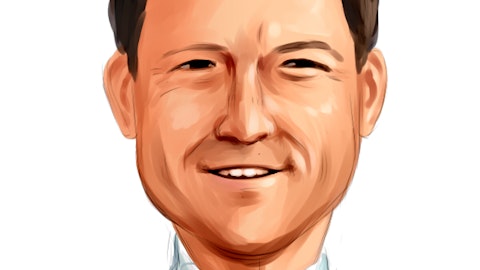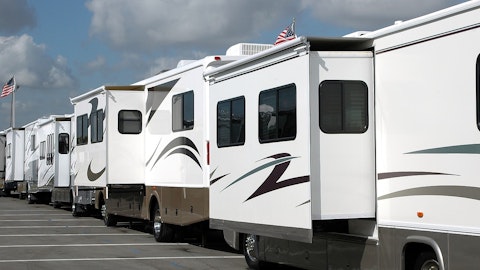Martin Landry: Hi, good morning. You’ve touched on next year and you expect sustained momentum and I was wondering if you can talk a little bit about industry retail sales in North America? Wondering what’s your assumption for industry retail sales to do next year?
Sébastien Martel: Well, again, it’s a tough call, Martin, and I guess my crystal ball is probably not better than your crystal ball, but there’s a few things that make us optimistic if I just look at the industry side. If you take side-by-side, the industry is down rolling 12 months. And even if we were to have a flat industry next year, I mean it’s down versus the peak of COVID, probably 25% down versus the peak of COVID. If we were just to maintain the market share that we have in Q3, it would represent almost a 10% volume growth just next year for us. So even with a flat industry, we’d be able to generate growth with market share gains that we’ve experienced. If you look at the personal watercraft industry, the season that just ended, it was the weakest season for personal watercraft since 2017.
Snowmobile also had weak season. So our expectation is that for main seasonal products, the industry should be higher than what we’ve experienced this year. But despite all of that, with flat to modestly increasing industries for seasonal, we are comfortable in our ability to generate growth next year.
Martin Landry: Okay. That’s helpful. And I’d like to just touch on Europe or EMEA. Your retail sales there were up 34% year-over-year, significant outperformance. I was wondering a little bit, was that related to preorders or are you still seeing new orders coming in? Just trying to get a bit of understanding of how the consumer is living the economic and political challenges?
José Boisjoli: Yes. Good morning Martin. What we’re hearing from dealers, and it’s even the case in North America, but more in Europe, there is less traffic in the dealership. That being said, worldwide we do less promotion because we don’t want to attract dealers — customers to the dealership, and they have nothing to see. Then we slowed down the promotion. There is less traffic. Also customers are trained right now. If they go in the dealership, they don’t have a new product out there, then there is — except for the traffic at the dealership and maybe specific country like UK, where it’s more difficult, retail is still strong. Like you said, North America without Sea-Doo pontoon was 39 and EMEA was 34. And dealer orders, we had our Club in August, and we gave to the dealer three months, I think, to complete — two months to complete their booking for model year 2023, and the booking of the dealer came out stronger than what we were planning and they are the front line.
They are the one who meet the customer really. Then we’re hearing like you do, like everyone do the tough situation with energy and all this in Europe, but it don’t show in our numbers.
Martin Landry: Okay, that’s it from me. Thank you.
José Boisjoli: Thank you.
Operator: Next question will be from Fred Wightman at Wolfe Research. Please go ahead.
Fred Wightman: Hey guys, good morning. I was hoping you could just sort of put the 3Q results into context. I know if we go back last quarter, you had given us some guide rails about where you thought EPS would sort of shake out 3Q versus 4Q. So the 4Q — like was 3Q just much stronger? Is there anything that’s giving you a little bit of caution about 4Q or did the Street just sort of have things modeled inappropriately?
Sébastien Martel: It’s very much modeling. Obviously, when we talked in September for the Q2 results, we were coming on the cyber incident. We were also looking at the supply chain. So there was some, I guess, cautiousness or we were gun shy on the Q3 numbers maybe a bit. But the teams outperformed, both on the recovery from the cyber incident, on managing supply chain, on the utilization of capacity. And so we were able to deliver more units than expected in the third quarter. So these are units that were planned in Q4 that now are carried forward or carried earlier in Q3. And also expenses as well, we continue to manage them tightly, and that came in lower than expected as well, so helping deliver the strong Q3 results.





